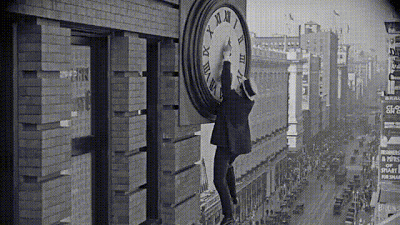THE GLASS CHARACTER
A novel by Margaret Gunning
Published in April 2014 by Thistledown Press
I would like to introduce you to my third novel, The Glass Character, a story of obsessive love and ruthless ambition set in the heady days of the Jazz Age in the 1920s. This was a time when people went to the movies almost every day, living vicariously through their heroes: Valentino, Garbo, Fairbanks and Pickford. But comedians were the biggest draw, and broad slapstick the order of the day - with one very significant exception.
Standing beside Keaton and Chaplin in popularity and prowess was a slight, diffident man named Harold Lloyd. He hid his leading man good looks under white makeup and his trademark black-framed spectacles. Nearly 100 years later, an iconic image of Lloyd remains in the popular imagination: a tiny figure holding on for dear life to the hands of a huge clock while the Model Ts chuff away 20 stories below.
With his unique combination of brilliant comedy and shy good looks, Lloyd had as many female followers as Gilbert or Barrymore. Sixteen-year-old Muriel Ashford, desperate to escape a suffocating life under her cruel father's thumb, one day hops a bus into the unknown, the Hollywood
When her idol Harold Lloyd walks on the set, her life falls into a dizzy whirl of confusion, attraction, and furious pursuit. Muriel tries on and sheds one identity after another: bit actress, waitress in a speakeasy, "girl reporter", script writer - while Lloyd almost literally dances in and out of her desperately lonely world, alternately seducing her and pushing her away.
While researching this book, I repeatedly watched every Lloyd movie I could get my hands on. I was astonished at his subtlety, acting prowess and adeptness at the art of the graceful pratfall. His movies are gaining new popularity on DVD (surprisingly, with women sighing over him on message boards everywhere!). The stories wear well and retain their freshness because of the Glass Character's earnest good nature and valiant, sometimes desperate attempts to surmount impossible challenges.
Introduction: Why Harold Lloyd?
The
Glass Character is
a fictional account of a young girl’s experiences in Hollywood 1962, in which she develops a relationship
with silent film comedian Harold Lloyd. Though I did extensive research in
exploring the era in general and his life in particular, this story is not
intended to be a biography of Lloyd. My main purpose was to
communicate atmosphere: the excitement, exuberance and joy of these “high and
dizzy” times.
With his boyish good looks and appealing everyman persona, Lloyd was no less than the inventor of an entire film genre: the romantic comedy. These sample remarks from YouTube (all by women) indicate a charm and magnetism that reaches across generations:
I think he
was and still is one of the most attractive men ever to walk the earth. I
absolutely love him!
Each time I
watch his movies I fall in love a little more.
He is sooooooo funny and the most handsome man ever!
Talented,
funny, smart, creative and damn gorgeous!
I find him
really attractive with his glasses on, and you can’t beat that half-shy,
half-sly smile of his.
I don’t
want to say it but he is in my fantasies. . . sigh.
When I sat
down to write, words often tumbled out at a fever pitch. Many of the scenes
came to me out of sequence, as if I were shooting a movie. Inspiration had a
timetable of its own and sometimes happened on holiday (can you believe I
almost missed the Grand Canyon ?). This had never happened to me before, and I had to take a few leaps
of faith to believe I could ever piece it all together.
Plunging
into his pictures to such depth, I experienced an immediacy, even an intimacy I
had never known before. I was breathing in the gunpowder and the dust and the
sweating horses and the she-loves-me/she-loves-me-not flowers and the white
greasepaint. I could hear “roll ‘em” and “cut!” and “damn, we’ll have to do
that again.” I was seeing that wonderful “half-shy, half-sly” smile of his in
person.
Though
Lloyd’s work has been gloriously reborn through the medium of DVD, he is still
too frequently seen as a bronze medallist after those two other legendary
figures from the silent age: Charlie Chaplin and Buster Keaton. It’s time to
throw away useless comparisons and hierarchies (is Picasso “better” than Van
Gogh? And how about Rembrandt – why does the poor fellow always come in
third?), and appreciate Lloyd’s movies for what they are. He is so much more
than the “everyman” of popular description. His Glass Character is a subtle,
slightly surreal, heart-touchingly brave and boyish silent clown, and if you
don’t watch out, he will take up residence in your heart, perhaps for good.
This is
Harold Lloyd the way I see him. I hope you enjoy this story.







No comments:
Post a Comment
Comments